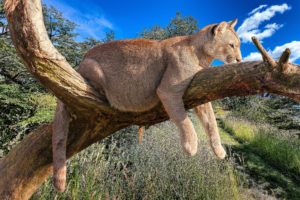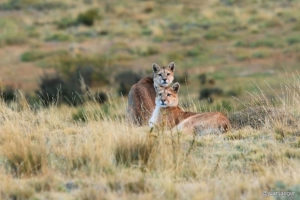Pumas — the cat that rules Torres del Paine
July 11, 2018 - 3 minutes read Found all the way from Alaska to Patagonia, they are the most widely dispersed big cat in the western hemisphere, as well as the most adaptable to different environmental conditions and the presence of mankind.
Found all the way from Alaska to Patagonia, they are the most widely dispersed big cat in the western hemisphere, as well as the most adaptable to different environmental conditions and the presence of mankind.
Given their inherent caution and stealthy nature, they’re nearly impossible to see in the wild — unless you’re being stalked by one. About the only place on the planet (other than a zoo) where you’re almost guaranteed a puma sighting is Torres del Paine National Park in southern Chile, home to about 50 of the big tawny colored cats.
Pumas have roamed the Earth for a long time and are known by a number of different names including panther, cougar, mountain lion, catamount, mountain screamer and painter. While cougar is the more commonly used term in North America, South Americans call them puma — a Quechua word meaning powerful.
Chile boasts three subspecies: Felis concolor puma in the Atacama Desert and Altiplano of northern Chile; Felis concolor araucanus in the Central Valley; and Felis concolor patagonica in the southern Andes and adjacent pampas.
Their relatively high numbers in 900-square-mile Torres del Paine is due to abundant prey (especially hares and guanacos), the vast expanse with  few human inhabitants, the camouflage provided by the park’s yellow grasses and reddish scrub, and the fact they haven’t been hunted for so long within the park boundaries.
few human inhabitants, the camouflage provided by the park’s yellow grasses and reddish scrub, and the fact they haven’t been hunted for so long within the park boundaries.
They have to travel over large expanses of treeless terrain to find, stalk and catch their prey — so they can’t hide all the time.
Puma are not enormous when compared to the hemisphere’s other big cat, the jaguar. Full-grown males stand about three feet at the shoulder and weigh up to about 220 lbs. They have amazing leaping potential, able to spring 15 feet without a running start and they can sprint at about 40-50 miles per hour. Adult females weigh between 64 and 140 lbs.
During the Patagonian summer (May–Oct), pumas tend to hunt in mountainous areas. But during the winter they follow the guanaco herds down to the areas below the snow line. So there’s probably a better chance of seeing them in the winter, when the park is much less busy.
That’s not to say it’s easy to spot a puma, even in Torres del Paine. Be on the lookout for condors and eagles circling kills or panicked guanacos. The big cats also return to prey killed the previous day.
One of the best ways to observe and photograph Felis concolor patagonica is joining the Puma Encounter Program offered by Hotel Las Torres.
Offered in October, November, December and March, the treks into puma country are led by an expert guide who’s been tracking and studying the big cats for more than a decade.
Ranging from three to five nights, the all-inclusive program includes other full-day and half-day excursions (like trekking and horseback riding) inside the park.
Tags: puma trekking in Chile, pumas in patagonia, torres del Paine National Park
0 Comments